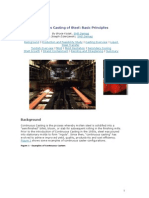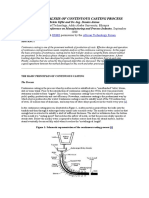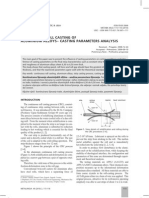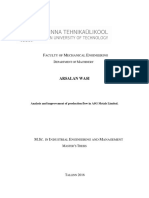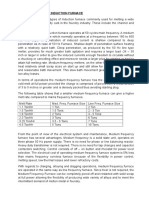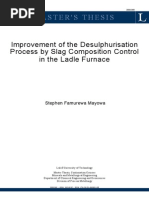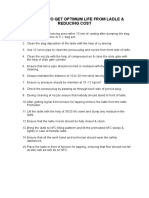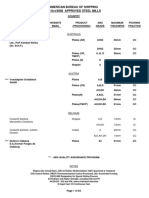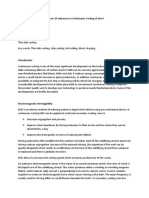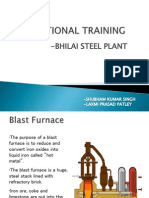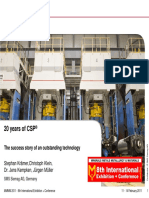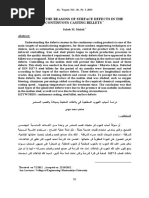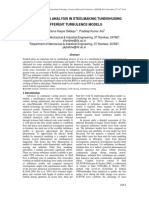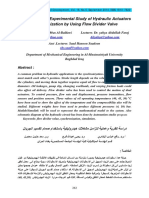Tundish CFD
Tundish CFD
Uploaded by
Amiy SrivastavaCopyright:
Available Formats
Tundish CFD
Tundish CFD
Uploaded by
Amiy SrivastavaOriginal Description:
Copyright
Available Formats
Share this document
Did you find this document useful?
Is this content inappropriate?
Copyright:
Available Formats
Tundish CFD
Tundish CFD
Uploaded by
Amiy SrivastavaCopyright:
Available Formats
Prepared by:- Manas V. More.
(133374006)
CFD modelling of liquid metal flow in
tundish and validation with an
experimental model
Guide:- Prof. Sandip Kumar Saha
Prof. Rajneesh Bhardwaj
7/5/2014 1 IIT Bombay
Contents
Tundish Fundamentals
Why CFD in tundish metallurgy?
Mathematical modelling
Previous work results and discussions
2 IIT Bombay 7/5/2014
Tundish Fundamentals
3 IIT Bombay 7/5/2014
Tundish Parameters
4 IIT Bombay 7/5/2014
Tundish geometry
Capacity
Refractory
Flow modifiers
Metering devices
Tundish slag
Source: Tundish metallurgy and clean steel,
Department of material science and engineering,
IIT-Kanpur, 21-22 September 2012.
Physio-Chemical Phenomena
5 IIT Bombay 7/5/2014
Ladle changeover and grade intermixing
Temperature drop and heat loss
Re-oxidation, inclusion generation
Slag emulsification
Slag vortexing
Inclusion removal
Strand freezing
Why CFD in tundish metallurgy?
6 IIT Bombay 7/5/2014
Design of tundish
Optimization of fluid flow
Turbulence or velocity distribution
Residence time
Inclusion floatation and removal
Appropriate location of flow control device
Mathematical modelling
7 IIT Bombay 7/5/2014
Boundary
conditions
Turbulence
model K-
Phase I (Melt)
Model
Phase II (Slag)
Model
Model outputs
Flow distribution,
Temperature
distribution,
Velocity
distribution,
turbulence field etc
Two phase, unsteady three dimensional flow
Incompressible Newtonian fluid
Isothermal
8 IIT Bombay 7/5/2014
Thermal energy transport in multiphase tundish:-
1. Liquid or primary phase thermal energy
conservation equation
=
2. Gas or secondary phase energy conservation
=
= Gas compressibility effect, = HTC/unit Vol.
h
c
= Heat transfer coefficient,
g
=
Hydrodynamic model
9 IIT Bombay 7/5/2014
Fluid flow mathematical modelling:-
Continuity and RANS equations
= Liquid density, (kg.m
3
)
u
i
= Velocity component in x
i
direction, (m.s
1
)
eff
= Effective viscosity, (kg.m
1
.s
1
)
eff
=
o
+
t
;
o
= Laminar viscosity &
t
= Turbulence viscosity.
= Thermal expansion coefficient of the molten steel, (K
1
)
The - model gives the turbulent viscosity as-
C
= 0.09, = Turbulent kinetic energy (m
2
.s
2
),
= Turbulent energy dissipation rate, (m
2
.s
3
)
10 IIT Bombay 7/5/2014
Fluid flow mathematical modelling:-
Turbulent K.E
Dissipation rate
=1.0, =1.3, =1.44, =1.92.
h = Enthalpy in (J.kg
1
) Pr
t
= 0.85,
C
P
= Specific heat (J.kg
1
.K
1
)
K
o
= Laminar thermal conductivity
k
eff
= Effective thermal
conductivity (Wm
1
K
1
)
11 IIT Bombay 7/5/2014
Transport and removal of inclusions:-
Langrangian particle tracking method-
= Inclusion location at any time, (m)
The inclusion velocity equation can be derived from the
force balance:
Total force acting on the inclusion F : F
D
+ F
G
m
p
= Particle mass,
a
p
= Particle acceleration rate,
u = Known liquid velocity, (m/s)
= Inclusion and liquid densities, (kg.m
3
)
Source: Tundish
metallurgy and clean steel,
Department of material
science and engineering,
IIT-Kanpur, 21-22
September 2012.
12 IIT Bombay 7/5/2014
Transport and removal of inclusions:-
C
D
= Drag coefficient as a function of inclusion Reynolds number
Turbulent fluctuation on the motion of inclusions are modeled using
- flow field by adding a random velocity fluctuation at each step.
Non-Stochastic model: Time averaged fluid flow velocity
Stochastic model:
u = Instantaneous fluid velocity, (m/s)
= Random velocity fluctuation, m/s.
13 IIT Bombay 7/5/2014
Volume of fluid method:-
Free surface or interface tracking method.
Phase Fraction whose values define the two phases
creating the interface.
Uses Eulerian approach - Interface movement is
calculated on a fixed grid.
Phase fraction:
Advection equation:
Source :International Journal of
Heat and Mass Transfer 49 (2006) 740754
14 IIT Bombay 7/5/2014
Volume of fluid method:-
Interface reconstruction-
Maintains accurate interface
shape in two-phase cells.
Reconstruction done using
Optimization Techniques : e.g.
Least squares Volume-of fluid
Interface Reconstruction
algorithm (LVIRA).
Continuous iterations calculating
interface normal and distance
for a given volume fraction in
two-phase cell.
Source :International Journal of
Heat and Mass Transfer 49
(2006) 740754
15 IIT Bombay 7/5/2014
Boundary conditions:-
Geometrical parameter
Molten metal properties
Process parameters
Source :
Lifeng Zhang, Fluid flow, heat transfer
and inclusion motion in molten steel
continuous casting tundishes, Fifth
International Conference on CFD,
Australia 13-15 December 2006
Previous work results and discussions
16 IIT Bombay 7/5/2014
Fluid flow: Isothermal & Non-isothermal Simulation
Source :
Lifeng Zhang, Fluid flow, heat
transfer and inclusion motion in
molten steel continuous casting
tundishes, Fifth International
Conference on CFD, Australia
13-15 December 2006
Previous work results and discussions
17 IIT Bombay 7/5/2014
Temperature distribution at longitudinal center face
Temperature distribution on walls and bottom of tundish
Source :
Lifeng Zhang, Fluid flow, heat
transfer and inclusion motion in
molten steel continuous casting
tundishes, Fifth International
Conference on CFD, Australia
13-15 December 2006
Previous work results and discussions
18 IIT Bombay 7/5/2014
Inclusion motion
Effect of random walk on
trajectory of inclusion
with different size.
Minimum and maximum
time required for
inclusion to travel to
outlet and top surface of
tundish
19 IIT Bombay 7/5/2014
THANK YOU
You might also like
- FUCHS Shaft Furnaces: The Power, The Performance, The ProfitDocument13 pagesFUCHS Shaft Furnaces: The Power, The Performance, The ProfitDhirender Kapoor100% (1)
- Start-Up Experience and Results of Consteel® at The SOVEL MeltshopDocument9 pagesStart-Up Experience and Results of Consteel® at The SOVEL Meltshopعمار احسنNo ratings yet
- A Bell-Type Annealing Furnac PDFDocument9 pagesA Bell-Type Annealing Furnac PDFfercho-kun satochiNo ratings yet
- Wire DrawingDocument18 pagesWire DrawingstaniNo ratings yet
- Steel - Continuous CastingDocument11 pagesSteel - Continuous CastingAli AzharNo ratings yet
- Thermal Analysis of Continuous Casting Process (Maryeling)Document10 pagesThermal Analysis of Continuous Casting Process (Maryeling)Marko's Brazon'No ratings yet
- Rolling DefectsDocument8 pagesRolling Defectsvelavansu100% (2)
- Defects 2 PDFDocument37 pagesDefects 2 PDFFongJeremyNo ratings yet
- Continuous Casting TheoryDocument12 pagesContinuous Casting Theoryyash_ganatra100% (1)
- How's Steel Manufactured?: Raw Materials For IronmakingDocument6 pagesHow's Steel Manufactured?: Raw Materials For IronmakingUpendra93No ratings yet
- Continuous Roll Casting of AluminiumDocument4 pagesContinuous Roll Casting of AluminiumLuis HernandezNo ratings yet
- Steel Making PDFDocument38 pagesSteel Making PDFAbdullah Asif NomanNo ratings yet
- Centrifugal Shroud Tundish SteelmakingDocument12 pagesCentrifugal Shroud Tundish Steelmakingdebasish chatterjeeNo ratings yet
- Steel PlantDocument68 pagesSteel PlantRohithNo ratings yet
- ASG+Metals+ASteel MakiDocument96 pagesASG+Metals+ASteel MakikooldeepNo ratings yet
- Selection of Stirring and Shrouding Gases For Steelmaking Applications PDFDocument20 pagesSelection of Stirring and Shrouding Gases For Steelmaking Applications PDFRasul BzNo ratings yet
- Medium Frequency Induction FurnaceDocument5 pagesMedium Frequency Induction FurnaceSreekumar RajendrababuNo ratings yet
- CONTINUOUS CASTING ColloquiumDocument18 pagesCONTINUOUS CASTING ColloquiumakritiNo ratings yet
- Thesis Slag DesulphurisationDocument66 pagesThesis Slag DesulphurisationRAULYEPEZSANCHEZNo ratings yet
- 7B-4 Charging HM in EAF's - Reducing Cost PDFDocument16 pages7B-4 Charging HM in EAF's - Reducing Cost PDFChristiani Hera TangkealloNo ratings yet
- Metal Scrap Preheating Using Flue Gas Waste HeatDocument8 pagesMetal Scrap Preheating Using Flue Gas Waste HeatDiptoNo ratings yet
- VacuumTreatmentofMoltenSteelRHRuhrstahlHeraeusvs VTDVacuumTankDegasser PDFDocument17 pagesVacuumTreatmentofMoltenSteelRHRuhrstahlHeraeusvs VTDVacuumTankDegasser PDFkalaiNo ratings yet
- Blast FurnaceDocument11 pagesBlast Furnacesiddhant raut100% (1)
- Training 2 LF FundamentalsDocument64 pagesTraining 2 LF Fundamentalsprasenjitsayantan100% (1)
- Ladle TypesDocument16 pagesLadle Typessteelage100% (1)
- Charging 80% Hbi in Eaf Sidetur-Casima ExperienceDocument27 pagesCharging 80% Hbi in Eaf Sidetur-Casima Experienceyd_tripathi4792No ratings yet
- Chapter 10Document136 pagesChapter 10dertas6641100% (1)
- Sop of Ladle LIFEDocument1 pageSop of Ladle LIFEMurali Krishnan Nair100% (1)
- 85% High Alumina Refractory Brick Specs: Brand Properties DL-87WDocument2 pages85% High Alumina Refractory Brick Specs: Brand Properties DL-87WHasan Ash100% (1)
- ABS Approved Still Mill PDFDocument84 pagesABS Approved Still Mill PDFJanuar Target Willyam0% (1)
- Endless Casting and Rolling of Long Products: The Competitive Substitute of Conventional Mini-MillsDocument8 pagesEndless Casting and Rolling of Long Products: The Competitive Substitute of Conventional Mini-MillsJJNo ratings yet
- Review On 20 HI Cold Rolling Mill Rolls and SpallingDocument6 pagesReview On 20 HI Cold Rolling Mill Rolls and SpallingIJRASETPublications100% (1)
- Advances in Continuous Casting PDFDocument4 pagesAdvances in Continuous Casting PDFPrakash SarangiNo ratings yet
- 4 AodDocument5 pages4 AodSonu MishraNo ratings yet
- Study On Partial Replacement of Coarse Aggregate With Steel SlagDocument9 pagesStudy On Partial Replacement of Coarse Aggregate With Steel SlagIJRASETPublicationsNo ratings yet
- Li-2018 - Flatness Control Capability of Cold Rolling MillDocument13 pagesLi-2018 - Flatness Control Capability of Cold Rolling Milldean chenNo ratings yet
- EAT227-Lecture 2.3 - Continuous CastingDocument25 pagesEAT227-Lecture 2.3 - Continuous CastingSurya Da Rasta100% (1)
- Pomina Steel enDocument2 pagesPomina Steel enrazen_in0% (1)
- 1006 Casting ProblemsDocument113 pages1006 Casting ProblemsParam SaxenaNo ratings yet
- BFDocument56 pagesBFvikrantsingh2908No ratings yet
- Tundish Inclusion ArrestDocument71 pagesTundish Inclusion ArrestAmiy SrivastavaNo ratings yet
- Vocational TrainingDocument43 pagesVocational TrainingShubham Kumar Singh100% (1)
- AGC TenovaDocument2 pagesAGC TenovaVikram TambeNo ratings yet
- TQM For Steel Bars PDFDocument36 pagesTQM For Steel Bars PDFImtiazuddin AhmedNo ratings yet
- Powder MetallurgyDocument96 pagesPowder Metallurgykhare_girishNo ratings yet
- 20 Yrs of CSP Technology PDFDocument27 pages20 Yrs of CSP Technology PDFBhoomaiah SunkenapalliNo ratings yet
- Refractory Materials For Different Parts of Electric ARC Furnace - Catherine Gao - Pulse - LinkedInDocument4 pagesRefractory Materials For Different Parts of Electric ARC Furnace - Catherine Gao - Pulse - LinkedInceng el samiuNo ratings yet
- ElectroSlag Remelting Furnace Guide enDocument8 pagesElectroSlag Remelting Furnace Guide enFernando ArévaloNo ratings yet
- Continuous CastingDocument67 pagesContinuous CastingPatel Ki Bahu100% (1)
- Are View of The Rhomboid It y Problem in Billet CastingDocument11 pagesAre View of The Rhomboid It y Problem in Billet CastingSuhaib AshrafNo ratings yet
- Achenbach ExtractDocument56 pagesAchenbach ExtractCatanescu Alexandru-LaurentiuNo ratings yet
- Progress of Emission Control System in EAF ShopsDocument8 pagesProgress of Emission Control System in EAF ShopsJoão CoelhoNo ratings yet
- Non-Circular Grinding of Backup Rolls To Reduce Rolling Force VariationDocument12 pagesNon-Circular Grinding of Backup Rolls To Reduce Rolling Force VariationAli RayyaNo ratings yet
- Unit 1 Metals and Melting Practices: StructureDocument45 pagesUnit 1 Metals and Melting Practices: StructureTapas BanerjeeNo ratings yet
- Continues Casting DefectDocument11 pagesContinues Casting Defectreza razaviNo ratings yet
- Grade Mixing Analysis in Steelmaking Tundishusing Different Turbulence ModelsDocument6 pagesGrade Mixing Analysis in Steelmaking Tundishusing Different Turbulence ModelsrakukulappullyNo ratings yet
- Experimental Estimation of Critical Buckling Velocities For Conservative Pipes Conveying FluidDocument10 pagesExperimental Estimation of Critical Buckling Velocities For Conservative Pipes Conveying FluidEmad ElsaidNo ratings yet
- 05 CFD2005 Zhang Ver2.8Document9 pages05 CFD2005 Zhang Ver2.8Khalil LasferNo ratings yet
- LWAASHJSPLANGULDocument5 pagesLWAASHJSPLANGULAmiy SrivastavaNo ratings yet
- Effect On The Tundish Cover by Ladle SlagDocument15 pagesEffect On The Tundish Cover by Ladle SlagAmiy SrivastavaNo ratings yet
- Jindal Panther PDFDocument11 pagesJindal Panther PDFAmiy SrivastavaNo ratings yet
- Light BeamDocument1 pageLight BeamAmiy SrivastavaNo ratings yet
- Tundish Inclusion ArrestDocument71 pagesTundish Inclusion ArrestAmiy SrivastavaNo ratings yet
- Inclusion RemovalDocument11 pagesInclusion RemovalAmiy SrivastavaNo ratings yet
- Crime Hot-Spots Prediction Using Support Vector Machine: 952 1-4244-0212-3/06/$20.00/©2006 IEEEDocument8 pagesCrime Hot-Spots Prediction Using Support Vector Machine: 952 1-4244-0212-3/06/$20.00/©2006 IEEEVanessaHCNo ratings yet
- Lecture 5 Karnaugh MapsDocument34 pagesLecture 5 Karnaugh Mapsmohamedsalahrohaim09No ratings yet
- Pipe NetworkDocument48 pagesPipe NetworkMD Al-AminNo ratings yet
- Index - Intelligent Music ProductionDocument7 pagesIndex - Intelligent Music Productionipirate391No ratings yet
- 5-11-2024 DEV Question BankDocument3 pages5-11-2024 DEV Question Bankknightneptune05No ratings yet
- Ryan International School, Ghaziabad 2020-2021 Date DAY Subject Saturday Monday ScienceDocument6 pagesRyan International School, Ghaziabad 2020-2021 Date DAY Subject Saturday Monday ScienceMuddpossNo ratings yet
- Chapter 1 Ncert XIIDocument16 pagesChapter 1 Ncert XIIaaditya160807No ratings yet
- Theoretical and Experimental Study of Hydraulic Actuators Synchronization by Using Flow Divider ValveDocument12 pagesTheoretical and Experimental Study of Hydraulic Actuators Synchronization by Using Flow Divider ValverezaNo ratings yet
- Calculating Call Center StaffDocument5 pagesCalculating Call Center StaffMohammed H Al HubashiNo ratings yet
- Applied Mathematics in Engineering and Reliability PDFDocument354 pagesApplied Mathematics in Engineering and Reliability PDFJayson Jonson AraojoNo ratings yet
- CNC Data Acquisition: System Development and ValidationDocument4 pagesCNC Data Acquisition: System Development and ValidationjamilvoraNo ratings yet
- Inductive ReasoningDocument14 pagesInductive ReasoningJAKE DANIEL RAPADANo ratings yet
- Solids With V BHDocument8 pagesSolids With V BHDavid OrtegaNo ratings yet
- MLE 1101 Fall 2008 Tutorial IIDocument23 pagesMLE 1101 Fall 2008 Tutorial IIAlexander ZeusNo ratings yet
- 04 Lexi Cal A AnalysisDocument39 pages04 Lexi Cal A AnalysisJyoti TripathiNo ratings yet
- Optimization of B-Pillar Roof Crush TestDocument23 pagesOptimization of B-Pillar Roof Crush TestManju sattigeriNo ratings yet
- Solving Systems of Equations NotesDocument6 pagesSolving Systems of Equations NotesNarvelle FerdinandNo ratings yet
- Rational Vs Irrational Number ProjectDocument1 pageRational Vs Irrational Number ProjectSagnik GhoshNo ratings yet
- Ls Maths8 2ed TR Workbook Answers-2 PDF Mathematical Analysis NumbersDocument1 pageLs Maths8 2ed TR Workbook Answers-2 PDF Mathematical Analysis NumbersshweyeescarletNo ratings yet
- Forward and Inverse Kinematics of Orientation: Unit - 3Document13 pagesForward and Inverse Kinematics of Orientation: Unit - 3basharat hussainNo ratings yet
- Mathematics Matrices: Vibrant AcademyDocument26 pagesMathematics Matrices: Vibrant AcademyIndranilNo ratings yet
- Definition of Hyperbolic FunctionsDocument7 pagesDefinition of Hyperbolic FunctionsKenny WilliamsNo ratings yet
- Subjective Sm015 PelajarDocument23 pagesSubjective Sm015 PelajarWAN NUR ALEEYA TASNIM BINTI WAN MOHAMED HAZMAN MoeNo ratings yet
- 6 - Material Balance EquationDocument44 pages6 - Material Balance EquationlervinofridelaNo ratings yet
- 5 B treeDocument61 pages5 B treeGovind 025No ratings yet
- BCOM SCM - Y1 - Statisitcs 102 - NOV 2017 EXAMSDocument7 pagesBCOM SCM - Y1 - Statisitcs 102 - NOV 2017 EXAMSlondiwe.langa04No ratings yet
- Gauss SeidelDocument7 pagesGauss SeidelGunvir SinghNo ratings yet
- En Tanagra Perfs Comp Decision TreeDocument15 pagesEn Tanagra Perfs Comp Decision TreeRodolfo Sabala VeilesNo ratings yet
- Gen Math Rep.Document32 pagesGen Math Rep.Mikee T. DemecilloNo ratings yet




